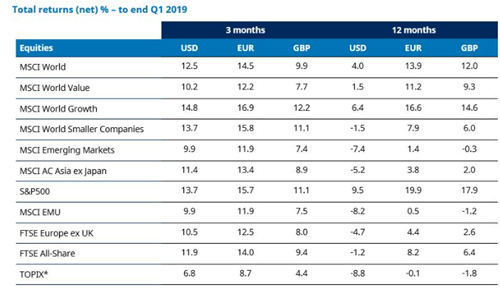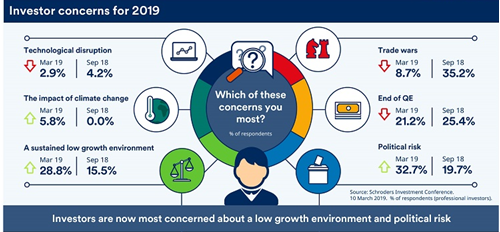The first quarter of 2019 and into April has delivered substantial returns for risk assets. The decline of the final quarter of 2018 has been reversed and equity markets once again are heading for new highs. This somewhat crazy six months highlights the perils of investors concentrating on quarters or even shorter periods. There is great temptation to be drawn in to peering at portfolios and make long term decisions on short term information and reactions.
Equity markets made gains in the first quarter, rebounding from a weak end to 2018 as concerns over the China-US trade dispute eased and major central banks grew more accommodative. Government and corporate bonds advanced. US equities rose, fuelled mainly by an increasingly dovish tilt in Federal Reserve commentary, and apparent progress in US-China trade talks. The US was also boosted as the government shutdown ended.
Eurozone equities also recovered well, supported by central banks stepping away from tighter monetary policy. However, worries over economic growth lingered throughout the quarter. UK equities performed well over the quarter, despite ongoing Brexit-related uncertainty, and were in line with global equities.
Japanese shares gained but the advance was somewhat muted compared to other developed markets. Emerging markets equities registered a strong return in the quarter, led by China. Optimism over a trade agreement with the US and ongoing government support for the Chinese domestic economy were beneficial.

The table above (Source: Schroders/Thomson Reuters DataStream) shows the returns achieved by the major risk assets in the first three months of 2019. We cannot expect that this type of return can be repeated through the remaining quarters of 2019, no matter how good that would feel. Global growth is likely to remain subdued and corporate earnings may struggle to meet investors’ expectations. However, recession seems a much less likely scenario, particularly in the US, which was a concern swirling round markets at the end of last year.
Time will tell whether the Fed will act pre-emptively to support activity in the coming months. In the meantime, a more dovish Fed, combined with the news that quantitative tightening will end in September, has supported fixed income markets this year, from government bonds to credit.
On trade, while some progress seems to have been made this quarter between the US and China, there is still uncertainty as to how the negotiations will evolve. Some of the underlying tension is unlikely to be resolved easily given that the US and China are ultimately competing in several key industries, such as technology. In addition, even if an ongoing truce can be agreed between the US and China, there is no guarantee that the US administration won’t turn towards a more confrontational trade policy with Europe, which has indeed commenced. Although as the Schroder’s chart of investors’ concerns shows below, trade war fears have greatly receded but growth and political risk have increased. So, on monetary policy and trade there are reasons for optimism, but also some risks given an optimistic outcome on both fronts is now already priced in.

For the recovery in markets to continue, the weakness in global growth will also have to recede, extending what has already been a very long economic expansion by historical standards. On this front, the data in the first quarter was more mixed.
Overall, markets end the first quarter with equities, credit and government bonds up for the year to date, buoyed by more dovish central banks and hopes for a truce on trade between the US and China. Easier monetary policy and less disruptive trade policies could continue to support markets, but we must remain cautious.
In many ways, the weakness in Q4 set the stage for the recovery in equity markets this quarter. The Federal Reserve reacted to the market weakness and weaker global growth by becoming more patient. Much of the rally this year has been built on market expectations that the Fed now won’t raise interest rates again at any point in the next few years – in fact, the next move expected from the Fed by the bond market is now a cut, with 10-year Treasury yields down to 2.4%.
The sharp fall in the US stock market late last year was probably also a factor in deterring the US administration from further increasing tariffs on China over the quarter. So, the stock market declines last year helped to reduce two of the major risks that had caused it in the first place.
It will be interesting to see how the second quarter develops as the recovery in the first quarter was not expected to this extent. Caution is the watchword.
Douglas Kearney C.A. Investment Director
The above article is intended to be a topical commentary and should not be construed as financial advice. Past performance is not an indicator of future returns. Any news and/or views expressed within this document are intended as general information only and should not be viewed as a form of personal recommendation.
